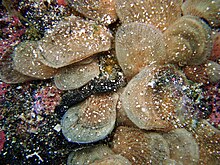Isognomon
|
Isognomon Temporal range: Permian - Recent |
|
|---|---|
 |
|
| Live Isognomon sp. under a rock in Kona District, Hawaii | |
| Scientific classification | |
| Kingdom: | Animalia |
| Phylum: | Mollusca |
| Class: | Bivalvia |
| Order: | Pterioida |
| Family: | Pteriidae |
| Genus: |
Isognomon Lightfoot, 1786 |
| Type species | |
|
Ostrea perna Linnaeus, 1767 |
|
| species | |
|
See text. |
|
| Synonyms | |
|
|
(For the tree oyster mushroom, see Pleurotus ostreatus.)
See text.
Isognomon is a genus of marine bivalve mollusks which is related to the pearl oysters.
Isognomon is known in the fossil record from the Permian period to the Quaternary period (age range: 254.0 to 0.012 millions years ago). Fossils of species within this genus have been found all over the world.
This genus was formerly placed in the family Isognomonidae, however molecular phylogeny studies have shown that these tree oysters belong in the family Pteriidae.
These oysters grow to be about 4.75 inches (12.1 cm) in overall length, producing a highly irregular shell with a blue-gray and often heavily encrusted exterior but a smooth and pearly white interior. They use their byssus to completely immobilize themselves to the roots of mangrove trees, corals, and other substrates. It is because of the preference for mangroves that these are sometimes called tree oysters
Extinct species within this genus include:
...
Wikipedia
